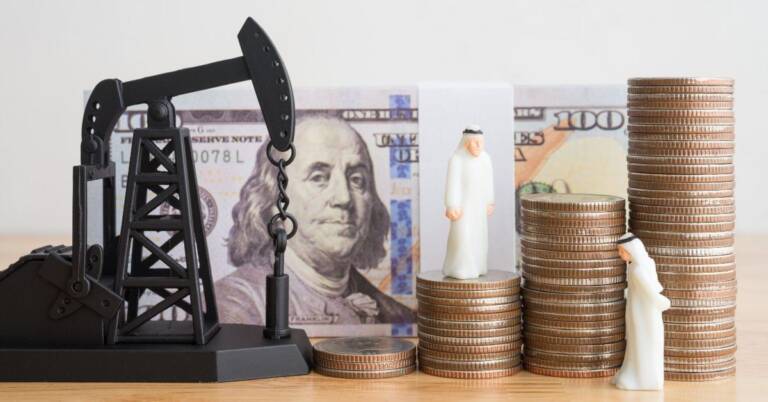What consequences will the end of the petrodollar agreement have on the economy and the USA?

Many more countries wish to use their national currencies in cross-border transactions, and, for this reason there is a growing perception that the dollar's importance in international finance is waning, particularly in global oil markets and in the use of the petrodollar . Also due to sanctions, the payment for oil resources in Rubles, Yuan, Rupees or Dhiram has increased.
But what exactly is the petrodollar? In short, this is Saudi Arabia's commitment to use dollar revenues from oil sales to the United States to purchase American government bonds. But the story is more complicated and we will start from some considerations by Hug Trahn of the Atlantic Council .
The agreement between America and Saudi Arabia in 1974
Let's take a step back to the Nixon administration. The United States was plagued by high inflation and large current account deficits, due to the ongoing war in Vietnam, which put downward pressure on the dollar and threatened a run on U.S. gold reserves.
In 1971, the United States ended the convertibility of the dollar into gold, which had been the cornerstone of the Bretton Woods international monetary system with fixed exchange rates. Major currencies began floating against each other in 1973. Then came the oil shock that fall, when the Organization of the Petroleum Exporting Countries (OPEC) cut oil production and blocked shipments to the United States during the Yom Kippur War.
Against a backdrop of great economic and political uncertainty, as the Watergate hearings drew to a close, the Nixon administration embarked on a diplomatic mission that would solidify an economic partnership with Saudi Arabia, which has been central to global energy trade .
To encourage Riyadh's use of the dollar as a medium of exchange for its oil sales (and then funnel those dollars into Treasury bond markets to help finance U.S. fiscal deficits), Washington promised to provide military equipment to Saudi Arabia and to protect its national security. Despite the turmoil and instability in the United States at the time, the agreement demonstrated that the country retained the power to set the international agenda.
In addition to keeping demand for the dollar stable, the agreement promoted its use in oil and commodity trading, while creating a steady source of demand for U.S. Treasuries. This has helped strengthen the dollar's position as the world's primary reserve, financing and transactional currency.
The emergence of a new world
Fifty years later, the dominant global position enjoyed by the United States has been relatively weakened. Its share of world gross domestic product has declined from 40% in 1960 to 25%. China's economy has surpassed the United States in terms of purchasing power parity. Now it must compete for influence with an increasingly assertive Beijing, while also facing pressure from allies such as Europe and other countries that want to become more autonomous from Washington in matters of financial and foreign policy. In particular, many countries have sought to develop alternative cross-border payment arrangements to the dollar, to reduce their vulnerability to Washington's increasing use of economic and financial sanctions.
At the same time, the United States has become much less dependent on Saudi oil. In fact, thanks to the shale revolution, the United States is now the largest oil producer in the world and a net exporter. They still import oil from Saudi Arabia, but at a significantly lower volume.
In contrast, China has become Saudi Arabia's largest oil customer, accounting for more than 20% of the kingdom's oil exports. Beijing has established close, trade-oriented relationships across the Middle East, where U.S. influence has waned. After all, China is a customer and, as we know, the customer is always right.
Saudi Arabia's willingness to diversify the currencies it uses to sell its oil aligns with a broader strategy that requires the country to increase its international relations beyond the United States and Europe. The Kingdom's willingness to join the BRICS club of emerging nations and collaborate with China and other countries in the mBridge project to explore the use of their respective central bank digital currencies (CBDCs) for cross-border payments is not surprising.
The global dollar dilemma
Saudi Arabia's interest in currency diversification marks a small but symbolic step towards de-dollarization. Increasingly, countries are using their own currencies in cross-border trade and investment transactions. The arrangements necessary to do so exist outside the influence of any great power. These include currency swap lines agreed between participating central banks and the linking of national payment and settlement systems.
Using local/national currencies for cross-border payments currently comes at an efficiency cost, as it relies on less liquid local foreign exchange, money and hedge markets to directly trade local currency pairs without the dollar as a vehicle . Many countries mentioned above appear to have accepted this cost as necessary to reduce their dependence on the dollar. Advances in digital payments technology, such as tokenization, would significantly reduce these costs.
In recent years, the digital payments ecosystem has progressed significantly towards the so-called “tokenization” of units of exchange such as CBDCs or stablecoins pegged to the dollar or any other major currency, a cryptocurrency designed to be pegged to an asset of reference, etc. These tokenized units can be traded instantly and directly, without having to be processed through the accounts of intermediaries such as commercial banks.
Tokenized currencies are still far from widespread adoption, but such an ecosystem would significantly reduce the need for participants to hold reserves to ensure adequate liquidity, weakening the role of the US Treasury securities market, deep and liquid, as a fundamental pillar to support the dollar's dominant position in international finance. Indeed, the dollar's share of global reserves has already fallen from 71% in 1999 to 58.4% today, in favor of several secondary currencies.
For the foreseeable future, the dollar's dominance will remain. But a gradual democratization of the global financial landscape may be underway, leading to a world where more local currencies can be used for international transactions. In such a world, the dollar would remain prominent, but without its excessive weight, complemented by currencies such as the Chinese renminbi, the euro and the Japanese yen, commensurate with the international footprint of their economies. In this context, Saudi Arabia's approach to the petrodollar remains as important a harbinger of the financial future to come as its creation fifty years earlier.
However, if the weight of the currencies is correlated to the weight on the world economy we will see a reduction in the weight of the USA and Europe in favor of emerging countries. A situation against which there will be no fiscal or monetary policy that can be useful in the long term. The only defense would be an economic expansion that the current policies of the various countries do not allow.

Thanks to our Telegram channel you can stay updated on the publication of new Economic Scenarios articles.
The article What consequences will the end of the petrodollar agreement have on the economy and the USA comes from Economic Scenarios .
This is a machine translation of a post published on Scenari Economici at the URL https://scenarieconomici.it/quali-conseguenze-avra-la-fine-dellaccordo-sul-petrodollaro-sulleconomia-e-sugli-usa/ on Sun, 23 Jun 2024 06:00:23 +0000.

